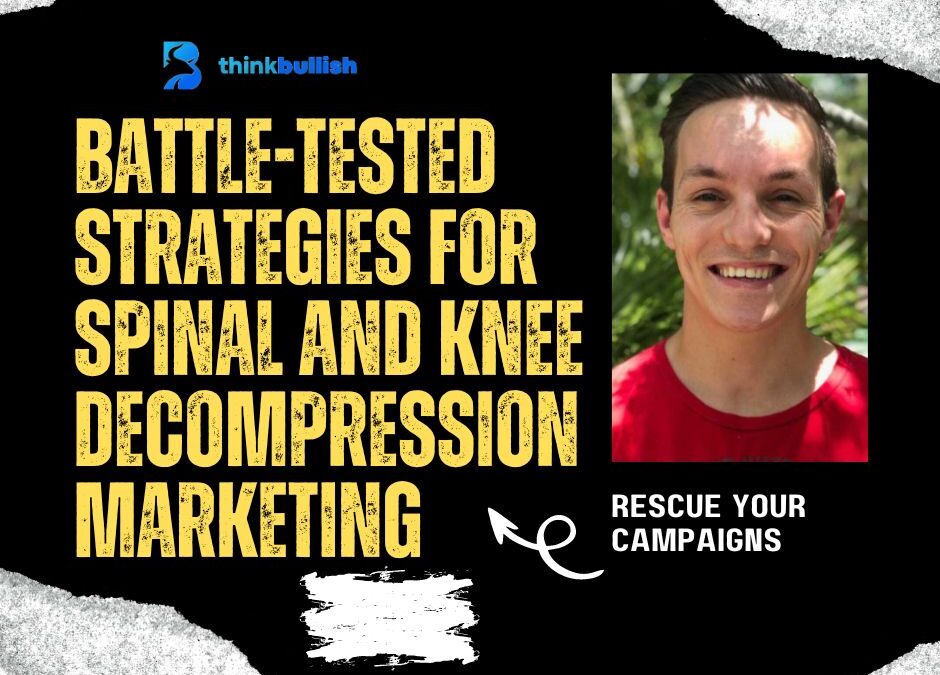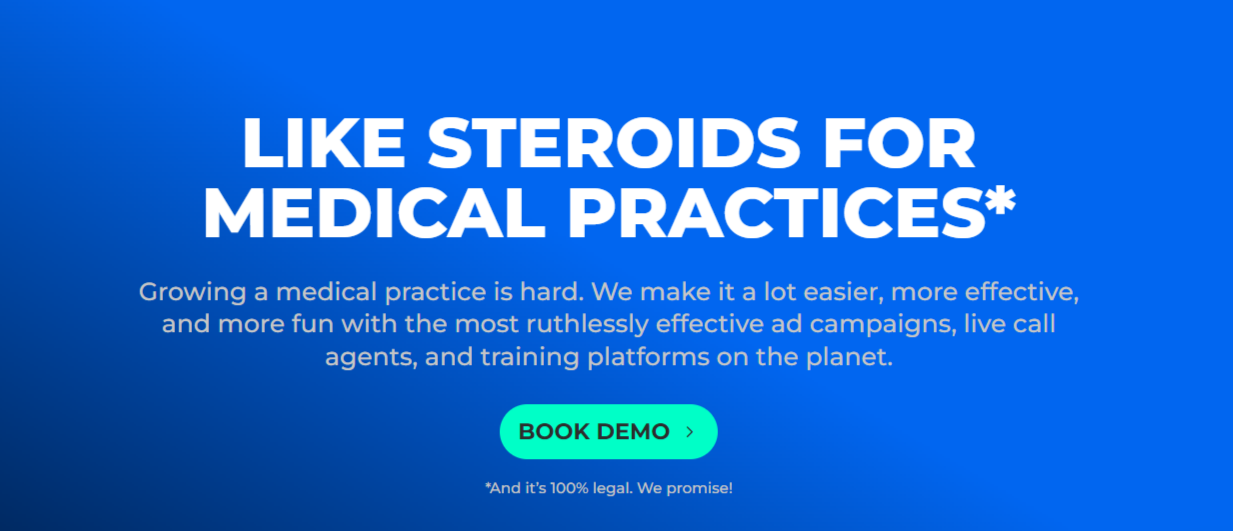Imagine this: You’re sitting at your desk, staring at your computer screen, feeling a mix of excitement and nervousness. You’ve decided it’s finally time to dip your toes into the world of Facebook ads, hoping to attract more patients to your practice.
But there’s a nagging voice in the back of your mind, reminding you what happened the last time you tried this.
- The results were not that impressive, to say the least.
- You ended up spending money without seeing the returns you’d hoped for.
- It left you feeling frustrated and defeated.
Now, before you start pointing fingers at Facebook or yourself, let’s take a step back and consider something important: the lack of effective strategies aligned with your business goals.
It’s not just about throwing money at ads and hoping for the best. You see, successful marketing campaigns have certain characteristics that, when met, can produce remarkable results. These winning characteristics or elements:
- Work in cohesion to support your objectives.
- Drive results, drawing attention from your ideal patients.
- Guide them through a journey that ultimately leads to conversion.
And that’s exactly what we’re going to dive into in this blog post.
Let’s explore the essential elements that can turn your marketing campaigns into rocket launchers.
Also read: Adapting Spinal Decompression Marketing to Changing Trends
Essential Element #1: Systematic and Solid Funnel
Before launching your marketing campaign, it’s crucial to have a systematic, defined, and solid funnel in place. Think of your funnel as the roadmap guiding your prospective patients from initial contact to becoming valued clients.
Why Do You Need a Solid Funnel?
Simply put, your funnel can be your Google Maps to navigate the route to successful marketing campaigns. Plus, it is also great for your prospective patients. When they start their journey and move down the funnel, they feel guided and are nurtured to move down from top to bottom.
Provides Direction: A well-structured funnel keeps your marketing efforts aligned with your defined end goals. It ensures that every step you take contributes to moving potential patients through the conversion journey.
Keeps Marketing Efforts Tied to Results: Rather than juggling multiple strategies without clear direction, a solid funnel focuses your efforts on achieving tangible outcomes. It’s like having a roadmap that leads directly to success.
Crucial Components of a Systematic Funnel
Notice how I repeatedly emphasize the need for a solid and systematic funnel. That’s because clarity and structure are paramount. You want your prospective patients to feel prepared and nurtured as they progress through each stage of the funnel. Now, let’s break down the key components that make this mechanism effective and yield tangible results.
Opt-in Page: This is where you capture leads by offering something of value in exchange for their contact information. It could be a free guide, webinar, or consultation.
App Page: Once leads have opted in, direct them to an application page where they can provide more information about themselves and their healthcare needs. This step helps qualify leads and ensures you’re focusing on those most likely to convert.
Booking Page: After prospects have filled out the application, guide them to a booking page where they can schedule an appointment or consultation. Make the process seamless and user-friendly to encourage conversions.
Thank You Page: Finally, after prospects have booked their appointment, redirect them to a thank you page. This is an opportunity to express gratitude, provide additional resources or information, and reinforce their decision to choose your clinic.
Each page in your funnel plays a vital role in bringing your ideal patients one step closer to your clinic. The opt-in page captures their interest, the app page qualifies their intent, the booking page converts them into actual patients, and the thank you page fosters a positive experience and sets the stage for future engagement.
Additionally, the thank you page can serve as a valuable tool for securing credit card details and confirming payments, thereby enhancing the show rate and ensuring that patients follow through with their appointments. By implementing a systematic funnel, you streamline the conversion process and maximize the effectiveness of your marketing efforts.
Essential Element 2: Running Laser-Targeted Ads
Today, reaching your ideal patients is more attainable than ever, thanks to social media platforms like Facebook and Instagram. These platforms offer powerful tools for running laser-targeted ads that allow you to connect with precisely and accurately the audience you want to reach. Leveraging the wealth of data available on these platforms, particularly Facebook’s robust targeting options, you can create ads that are tailored to specific demographics, interests, and behaviors.
Running laser-targeted ads on platforms like Facebook doesn’t have to break the bank, either. With flexible budgeting options and the ability to set your ad spend limits, you can effectively manage your advertising costs while still reaching a highly targeted audience. This makes it an accessible and cost-effective strategy for healthcare practices looking to attract new patients and grow their business.
The benefits of running laser-targeted ads are numerous.
- You get to reach out to patients genuinely interested in your services
- You can deliver tailored and personalized messages
- You can keep and maintain your ad cost
By targeting your ads to a specific audience, you can ensure that your message reaches the people most likely to be interested in your services, maximizing your return on investment. In addition,, laser-targeted ads allow you to deliver personalized messages that resonate with your audience, increasing the likelihood of engagement and conversion. Finally, by focusing your advertising efforts on the most relevant audience segments, you can minimize wasted ad spend and achieve better overall results for your marketing campaigns.
If you’re interested in seeing real examples of how laser-targeted ads have yielded results for my clients, watch this recorded webinar. In this session, I walked through actual ad spends and the strategies behind them, showcasing how these essential elements can transform your marketing campaigns.
Essential Element 3: Creating Customer Avatar
Creating a customer avatar is not just a part of running laser-targeted ads; it’s the cornerstone of your entire marketing strategy. Your customer avatar represents your ideal patient—the person you want to attract to your practice. It’s a detailed profile that goes beyond basic demographics like age, gender, and location, diving deep into the interests, behaviors, and pain points of your target audience.
To create a customer avatar, start by defining who your ideal patient is and what they look like.
- Consider their age, gender, occupation, and family status.
- Think about their lifestyle, hobbies, interests, and the challenges they face daily.
- What are their goals, aspirations, and fears?
- What keeps them up at night, and what are they searching for in a healthcare provider?
By understanding your ideal patient on a deeper level, you can tailor your marketing efforts to speak directly to their needs and concerns. This goes beyond simply targeting them with ads; it’s about crafting messaging that resonates with them on a personal level. When your ideal patient sees your ads or reads your content, they should feel like you’re speaking directly to them, addressing their unique challenges and offering solutions that meet their specific needs.
Creating a customer avatar not only helps you target your marketing efforts more effectively but also guides your messaging, copywriting, and content creation. It ensures that every piece of content you produce is designed to attract and engage your ideal patient, ultimately driving better results for your marketing campaigns.
Essential Element 4: Long Copy
Building on the foundation of your customer avatar, a long-form copy is a powerful tool for engaging your ideal patients and guiding them through the decision-making process. When you have a clear understanding of who your audience is and what they’re looking for, you can create copy that speaks directly to their needs, concerns, and aspirations.
Long-form copy goes beyond the brief, punchy messaging often associated with social media ads. Instead, it allows you to dive deep into the benefits of your services, address common objections, and provide valuable information that helps your audience make informed decisions. By presenting a detailed and compelling case for your practice, you can build trust and credibility with your ideal patients, ultimately increasing the likelihood that they’ll choose you as their healthcare provider.
When writing long-form copy, it’s important to strike a balance between providing valuable information and maintaining the reader’s interest. One effective approach is to use storytelling to create a narrative that draws the reader in and keeps them engaged from start to finish. You can also incorporate testimonials, case studies, and other social proof to reinforce your message and build credibility.
In addition to engaging your audience, long-form copy can also have a significant impact on the success of your marketing campaigns. Studies have shown that longer content tends to perform better in terms of SEO, social sharing, and overall engagement. By investing the time and effort to create compelling long-form copy, you can maximize the effectiveness of your marketing efforts and attract more patients to your practice.
Essential Element 5: Practice Ascension Model Marketing
Have you ever gone to the grocery store with a clear intention to buy just one thing, but somehow ended up leaving with a whole cart full of items?
The situation seems familiar, right?
It’s not just a lack of self-control; it’s also the result of clever product placement and marketing strategies. This phenomenon is similar to how Ascension Model Marketing works.
When you practice ascension model marketing, you guide your patients to move up a ladder. You start by offering them something simple and then gradually introduce them to more advanced treatments or services. For example, let’s say you offer a free e-book about knee and spinal health. Then, you might offer a discounted initial consultation to those who download the e-book. From there, you could upsell them to a package of treatment sessions or a membership program for ongoing care.
The best thing about this approach is that it allows you to build trust and rapport with your patients over time. By providing value at each step of the journey, you’re more likely to retain their interest and loyalty. Plus, as they progress through the different levels of your offerings, you’re maximizing their lifetime value as patients.
Ascension model marketing is great for your spinal and knee decompression practice. It helps you cater to patients at different stages of their journey. Some may be ready to dive right into advanced treatments, while others may need more time to warm up to the idea. By offering a range of options, you’re more likely to appeal to a broader audience and attract more patients to your practice.
However, there are a few things to consider when implementing this type of marketing strategy.
- Make your upselling genuine
- Have pre-defined pathways for the patient journey
- Work on your pricing strategy shrewdly
So, first of all, you need to ensure that each step of the journey provides genuine value to your patients. If they feel like they’re being pushed into buying something they don’t need, they’re more likely to lose trust in your practice. Additionally, you need to have clear pathways for patients to progress from one level to the next. Make it easy for them to understand what’s available and how they can benefit from each offering. Finally, be mindful of pricing and affordability. While it’s important to offer high-value services, you also want to make sure they’re accessible to your target audience.
Essential Element 6: Have A Smart Sales Process
You can have the most innovative marketing strategies in place, but without a solid sales process to back them up, you may not see the tangible results you’re hoping for. A smart sales process is crucial for converting leads into paying patients and ensuring the success of your marketing efforts.
So, what exactly does a sales process involve?
It’s not just about closing deals. It’s about the entire journey a patient goes through, from the moment they express interest in your services to the point where they become a loyal advocate for your practice. This journey encompasses everything from the initial inquiry to the final payment and beyond.
Implementing a Smart Sales Process
To implement a smart sales process, you need to ensure that your operations and staff are equipped to handle the influx of patients that will come from your marketing efforts. This means having efficient systems in place for managing inquiries, scheduling appointments, and following up with leads. It also means training your staff to deliver exceptional service and providing them with the tools and resources they need to succeed.
Streamlining Operations
Streamlining your operations is crucial to a successful sales process. This includes everything from optimizing your appointment booking system to ensuring smooth communication between different departments. By eliminating bottlenecks and inefficiencies, you can ensure that the patient journey is seamless and stress-free.
Providing Ongoing Support
Finally, it’s important to provide ongoing support to both your patients and your staff. This means being responsive to patient inquiries and concerns, as well as providing training and professional development opportunities for your team. By investing in your staff and your systems, you can create a sales process that not only drives results but also enhances the overall patient experience.
In essence, a smart sales process is the backbone of your marketing efforts. By ensuring that you have efficient systems and processes in place, you can maximize the return on investment from your marketing campaigns and build long-term relationships with your patients.
Wrapping Up
These six essential elements form the backbone of a successful spinal and knee decompression marketing campaign. Through my experience working with various clients, I’ve seen firsthand the remarkable results that can be achieved by implementing these strategies.
What’s truly incredible about these elements is how they seamlessly interconnect to support each other. For instance, creating a customer avatar enables you to run laser-targeted ads, while compelling copywriting enhances the effectiveness of those ads. As you start attracting patients through your marketing efforts, you can then leverage the ascension model to further enhance their experience and increase their lifetime value.
By implementing these strategies in a cohesive and integrated manner, you can take your marketing campaigns to the next level and achieve sustainable growth for your practice. So, don’t hesitate to put these elements into action and watch your practice flourish.
Here’s to your success!
Ready to give these strategies a shot with expert guidance? Schedule a discovery call here to learn more about our services.
Check out similar posts and more on my blog archive.

Zack Siegel
Founder/CEO
Zack is a conversion rate lover and PPC ad man spending most of his time optimizing.
He’s an avid bookworm, Chipotle’s most valued customer, and pursuant stand-up comedian…
We give him reality checks every day.


